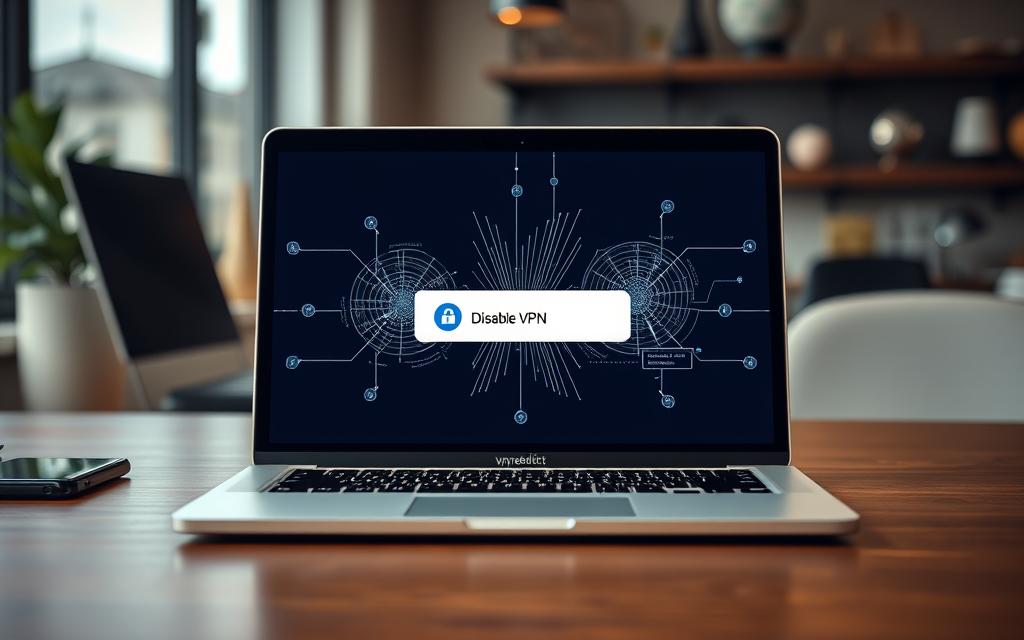How to Disable VPN if Im Using Parrelells on Mac
This article will show you how to turn off your VPN while using Parallels on your Mac. Parallels is a well-known virtual machine software. We’ll walk you through the steps to disconnect your VPN smoothly and fix any issues you might face.
It’s important to know how VPNs and Parallels work together to disable your VPN with Parallels on your Mac. We’ll cover the basics of both technologies. Then, we’ll give you a step-by-step guide to make it easy to follow.
Understanding VPN and Parallels on Mac
Before we dive into disabling your VPN in Parallels, let’s understand what a VPN is. A VPN (Virtual Private Network) encrypts your internet traffic. It also hides your IP address, making it hard for others to track your online activities. VPNs are used to access blocked content, protect your privacy, and keep you safe on public Wi-Fi.
Parallels is a virtual machine software. It lets you run different operating systems, like Windows, on your Mac. This means you can use Windows applications or test different environments without needing another device. Parallels works well with macOS, making it easy for Mac users.
Knowing how VPNs and Parallels work together is key for managing your virtual machine well. We’ll look at why you might turn off your VPN with Parallels. We’ll also show you how to do it step by step.
Reasons to Disable VPN While Using Parallels
Using Parallels on your Mac might make you think about turning off your VPN. Let’s look at why this could be a good idea.
One big reason is to make your system run better. VPNs can slow down your network, which hurts how well Parallels works. Turning off the VPN might make your system faster, let files transfer quicker, and make apps run smoother.
Another reason is to keep your network stable. Sometimes, VPNs can cause internet problems. Turning off the VPN helps keep your Parallels machine’s internet steady. This means you can use the internet without interruptions and work with others easily.
| Reasons to Disable VPN | Potential Benefits |
|---|---|
| Improved Parallels Performance | Faster application performance, smoother file transfers, and more responsive network interactions. |
| Stable Network Connectivity | Consistent and reliable internet access for your Parallels virtual machine. |
| Security Considerations | Reduced risk of security vulnerabilities associated with VPN connections. |
Turning off the VPN has its perks but also risks. Without it, your internet might be more at risk from hackers. You need to think about how it affects your security and find ways to stay safe.
In short, there are good reasons to turn off your VPN with Parallels on your Mac. These include better performance, stable internet, and reliability. But, you must think about the security risks and protect your virtual space.
Step-by-Step Guide to Disabling VPN in Parallels
If you’re using Parallels on your Mac and want to turn off the VPN connection, we’ve got you covered. We’ll show you how to find the VPN settings and disable the VPN in Parallels step by step.
Locating the VPN Settings
First, open the Parallels desktop application on your Mac. Then, find the “Settings” or “Configuration” option in the top menu or sidebar. Click on this to open the Parallels settings menu.
In the settings, you’ll see a section for “Network” or something similar. This is where you’ll find the VPN options. Make a note of where they are, as this is where you’ll disable the VPN connection.
Turning Off the VPN
Now, find the VPN settings to disable the VPN. You might need to toggle a switch, uncheck a box, or select “Disconnect” or “Turn Off”. Review the VPN settings carefully to find the right option.
Once you’ve found it, click or toggle it to disable the VPN. You might need to save or apply the changes before it’s fully turned off. After these steps, your Parallels virtual machine won’t use the VPN anymore.
The exact steps might change based on your Parallels version and VPN setup. If you have trouble, check your Parallels documentation or contact their support team for help.
Troubleshooting Common Issues
When we try to disable our VPN in Parallels on Mac, we might run into problems. One big issue is the VPN not turning off. Here, we’ll look at some tips to fix this and disconnect your VPN.
VPN Not Disabling Properly
If your VPN won’t turn off in Parallels, here are steps to help:
- Check your VPN settings: Make sure your VPN settings are right in Parallels and your system. Double-check the VPN connection and use the right credentials.
- Restart Parallels: A simple restart of Parallels might fix the problem. It refreshes the connection and clears glitches.
- Update Parallels and VPN software: Use the latest versions of Parallels and your VPN. Old versions can cause problems or bugs that stop the VPN from turning off.
- Look for conflicting network settings: Make sure no other network settings or apps on your Mac are messing with the VPN. Check for firewall rules, network extensions, or other VPN apps.
- Disable and re-enable the VPN: As a last step, try turning off and then back on the VPN in Parallels. This might reset the connection and fix any ongoing issues.
By trying these steps, you can usually fix the VPN not disabling issue in Parallels on your Mac.
Alternative Methods to Disable VPN
If disabling the VPN in Parallels isn’t working for you, there are other ways to try. These methods offer flexibility and might meet your needs better.
One way to disable your VPN is through your device’s settings. You can usually find the VPN settings and turn it off. The steps might change a bit depending on your device and platform, but they’re easy to follow.
Another choice is to use a VPN management app. Many VPN providers have their own apps. These apps let you easily connect, disconnect, and change your VPN settings. This way, you can quickly disable your VPN without going through system menus.
- Disable VPN through your device’s native settings
- Use a dedicated VPN management application
- Manually disconnect the VPN connection
You can also manually disconnect the VPN by closing the VPN client or app. This might take a bit more work, but it’s an option if other methods don’t work for you.
The best method depends on your needs, the VPN provider, and your device’s capabilities. Trying these alternative ways to disable your VPN can help you find the easiest and most reliable solution for your setup.

Security Considerations After Disabling VPN
When you turn off your VPN on your Mac, you need to watch out for security risks. It’s important to keep your online activities safe. Here are some key things to think about and do to protect yourself.
Potential Risks and Precautions
Without a VPN, your online actions and data could be at risk. Here are some risks and steps to take:
- Your internet use might be more open to spying. Be careful with sensitive info or private activities.
- There’s a higher chance of man-in-the-middle attacks. Watch out for these when using public Wi-Fi.
- You might not be able to see some websites or services because of your location.
To lower these risks, consider these steps:
- Use a good antivirus/antimalware to shield your system from threats.
- Don’t check sensitive info or do financial stuff on public Wi-Fi.
- Check your device’s network settings to make sure the VPN doesn’t turn on by accident.
- Look into proxy servers or Tor browser to get around geo-blocks when needed.
By taking these steps, you can still stay safe online even without your VPN while using Parallels on your Mac.
How to Disable VPN if I’m Using Parallels on Mac
If you’re using Parallels on your Mac and need to disable your VPN, we’ve got you covered. We’ll guide you through the steps to disconnect your VPN while using Parallels. This ensures a smooth process.
Locating the VPN Settings
First, find the VPN settings in Parallels. Open the Parallels app on your Mac, then go to the “Virtual Machine” menu and choose “Configure.” This opens the Parallels settings window, where you’ll see the VPN options.
Turning Off the VPN
After finding the VPN settings, just turn the VPN switch to “Off.” This will disconnect your VPN, letting you use Parallels without the VPN. Don’t forget to save your changes before leaving the Parallels settings.
By following these steps, you can easily disable your VPN in Parallels. This gives you full control over your Mac’s network while using the virtualization software.
| Step | Action |
|---|---|
| 1 | Launch Parallels on your Mac |
| 2 | Navigate to the “Virtual Machine” menu and select “Configure” |
| 3 | Locate the VPN settings within the Parallels settings window |
| 4 | Toggle the VPN switch to the “Off” position |
| 5 | Save your changes and exit the Parallels settings |
By following these steps, you can easily disable your VPN in Parallels. This gives you full control over your Mac’s network while using the virtualization software.
Verifying VPN Deactivation
After turning off your VPN in Parallels, make sure it’s really deactivated. This is key for your network’s security and proper function. We’ll guide you on how to check if your VPN is indeed inactive.
Checking Network Status
To see if your VPN is off, follow these steps:
- Open the System Preferences on your Mac.
- Click on the Network icon.
- Look at the network interfaces for the VPN connection. If you see it, the VPN is still on.
- If you don’t see the VPN, it means it’s successfully turned off.
You can also use the Terminal to check if your VPN is off. Just type this command:
networksetup -listnetworkserviceorder
This will show you your current network services, like any active VPNs. If the VPN isn’t there, you’ve successfully disconnected it. You can now use Parallels without VPN issues.
By doing these steps, you’ll know your VPN is off. This lets you use Parallels safely on your Mac.
When to Re-enable VPN
Disabling your VPN is sometimes needed, but you might need to turn it back on later. Here are situations where you should reactivate your VPN for security or to access blocked content.
One key reason to re-enable your VPN is for better security and privacy. If you’re accessing important info or doing secure tasks, turning your VPN back on protects your data. This is crucial when using public Wi-Fi or in places with strict internet rules.
Another reason is to get past geo-blocks and see content blocked in your area. This includes streaming sites, news, or online tools only available in some places. By reactivating your VPN, you can access this content and enjoy a better online experience.
If you see strange network activity after turning off your VPN, turn it back on as a safety step. This helps protect against security threats or privacy issues that might have happened without VPN.
In short, while it’s okay to turn off your VPN sometimes, remember when you should turn it back on. This keeps your online activities safe, lets you access blocked content, and protects your digital life.
Optimizing Parallels Performance Without VPN
After turning off your VPN in Parallels, you can boost your virtual machine’s performance. By tweaking a few Parallels settings, you can make your system run smoother. This means you can enjoy great computing without needing a VPN.
Here are some tips to make Parallels run better and improve your system settings without VPN:
- Adjust Resource Allocation: Make sure Parallels gets the right amount of system resources like CPU, memory, and storage. Try different settings to find the best balance for performance and stability.
- Optimize Graphics Settings: Adjust the graphics in Parallels to fit your needs. If you’re using it for work, you might not need high graphics settings. You can give more resources to other important tasks.
- Enable Hardware Acceleration: Use your Mac’s hardware power by turning on hardware acceleration in Parallels. This can greatly improve your virtual machine’s speed, especially for tasks that use a lot of graphics.
- Disable Unnecessary Services: Find and turn off any background services or processes in your Parallels machine that you don’t use. This frees up resources and makes your virtual environment more responsive.
- Leverage Parallels Toolbox: Check out the Parallels Toolbox, a set of tools to enhance your Parallels experience. These tools can help you set up your system better, manage virtual machines, and make tasks easier within Parallels.
By using these tips to optimize parallels and parallels settings without vpn, you can improve parallels performance. You’ll get a smooth computing experience on your Mac, even without a VPN.
| Setting | Recommendation | Impact |
|---|---|---|
| CPU Resources | Allocate the right number of virtual CPUs | Balances performance and stability |
| Memory Allocation | Assign sufficient RAM to the virtual machine | Ensures smooth multitasking and application performance |
| Graphics Settings | Optimize graphics resources based on usage | Enhances visual performance and responsiveness |
| Parallels Toolbox | Utilize the suite of optimization tools | Streamlines various tasks and enhances overall experience |
Conclusion
We’ve looked at how to disable your VPN while using Parallels on a Mac. By following our steps, you can turn off your VPN, fix any problems, and make your virtual machine run better.
We talked about the need to balance security and functionality. We showed you how to find and disable your VPN in Parallels. We also covered how to check if your VPN is really off. Plus, we discussed the risks of disabling your VPN and other ways to stay safe online.
When using Parallels and virtual machines, think about the security risks. Use the tips from this article to handle your VPN settings well. This way, you can improve your Parallels performance and have a smooth experience on your Mac.




